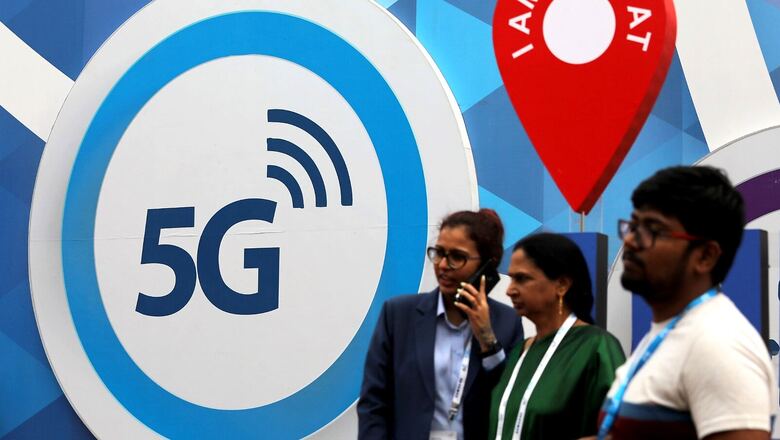
views
The 5G era dawned on India on Saturday as Prime Minister Narendra Modi launched the service to usher in the age of ultra-high-speed internet on mobile phones. The 5G service has been launched in select cities for now and will progressively cover the entire country over the next couple of years.
The cumulative economic impact of 5G is estimated to reach $450 billion by 2035. Capable of supporting ultra-high-speed internet, the fifth generation or 5G service is expected to unleash new economic opportunities and societal benefits, serving as a transformational force for Indian society.
At the launch, the three major telecom operators of India demonstrated the potential of 5G technology in India. Mukesh Ambani’s Reliance Jio connected a teacher from a school in Mumbai with students in three different locations in Maharashtra, Gujarat and Odisha.
In the Airtel demo, a girl from Uttar Pradesh witnessed a lively and immersive education experience to learn about the solar system with the help of virtual reality and augmented reality.
The Vodafone Idea test demonstrated the safety of workers in an under-construction tunnel of Delhi Metro through the creation of a ‘digital twin’ of the tunnel on the dias.
The display of India’s 5G prowess is a major milestone in the country’s telecom revolution, a journey that began in 1981.
The Starting Point
It all began in 1981 when the government attempted to liberalise the Indian telecommunications market. Previously, the Indian telecom sector was governed by state-run agencies under the Ministry of Posts and Telegraphs, in accordance with Nehruvian socialist policies that committed India to state-run, state-owned monopolies.
The sector’s expansion was gradual as the government was overburderned and Indians then generally viewed telephones as a luxury item and a status symbol rather than a necessity.
Later, then Prime Minister Indira Gandhi signed contracts with Alcatel CIT, a French telecommunications company, to merge the state-owned Telecom company ITI (Indian Telephone Industries Limited) to install 5 million telephone lines every year. But the endeavour was stalled because of political resistance.
In 1984, the Centre for Development of Telematics (C Dot) was formed by Sam Pitroda, who served as advisor to Indira’s successor and son Rajiv Gandhi, with the goal of building telecommunication technologies that would fulfil the needs of the Indian telecom network.
In 1985, the Department of Telecommunications (DoT) was established to look after the telecom services across the entire country. The next year, two independent corporations were set up — Mahanagar Telephone Nigam Limited (MTNL), which was tasked with handling telecom services in metro areas, and the other, Videsh Sanchar Nigam Limited (VSNL), which was responsible for handling international telecom services.
By the 1990s, the number of telephone lines in India had already topped 2.15 million. However, the government was pressured to open up the telecom sector to private sector investment as part of its 1991 liberalisation policy.
In 1992, private investments in the field of Value Added Services (VAS) were allowed and two years later, the government introduced the National Telecommunications policy (NTP), which restructured telecom infrastructure in terms of ownership, service and regulation.
Long distance still remained under the VSNL and DoT continued to focus on liberalising local telecom services.
The Birth of TRAI
In 1997, the government created the Telecommunications Regulatory Authority of India (TRAI).
A new telecom policy was also announced in 1999, under a new government formed by Atal Bihari Vajpayee, with new objectives and landmark targets such as ‘telephone on demand’ by 2002, telecom coverage of all villages by 2002, internet access to all villages by 2002, and so on.
Major policy changes included allowing multiple operators per circle, changing the licensing fee system to a one-time fee and introducing revenue sharing, allowing interconnection between service providers.
In 2000, the Indian government amended the TRAI Act and established the Telecom Disputes Settlement and Appellate Tribunal (TDSAT).
The object was to handle adjudicatory and dispute resolution functions, as well as TRAI’s regulatory authority in areas such as Frequency Spectrum Management, tariff powers, interconnection, quality standards, and time period for providing circuits between different service providers, and so on.
The same year, the government corporatised the DoT’s service arm, which was later renamed Bharat Sanchar Nigam Limited (BSNL). As a result, private players were allowed to enter the telecom sector without restrictions.
However, in 2008, VSNL was privatised.
The government once again renewed the policies and objectives for the sector through NTP 2012, which introduced the idea of ‘one nation-one licence’. The goal was to take advantage of the benefits of convergence, spectrum liberalisation and decoupling of network licensing from service delivery.
Another important aspect of the revised policy was to boost the availability of appropriate spectrum and ensure its transparent allocation through market-based methods.
2G, 3G, 4G
In India, mobile telephones began with the 2G cellular network and quickly progressed to a 3G or third-generation mobile network.
In 2008, MTNL launched the first 3G telecom services in India.
While 2G enabled digital phone calls and messaging, 3G enabled internet data connectivity on mobile devices, allowing for mobile internet access as well as phone calls and texting.
In 2012, Airtel launched India’s first 4G services. 4G brought faster data speeds and lower latency rates, which allowed online video-streaming to be possible on mobile phones.
Read all the Latest Tech News and Breaking News here




















Comments
0 comment